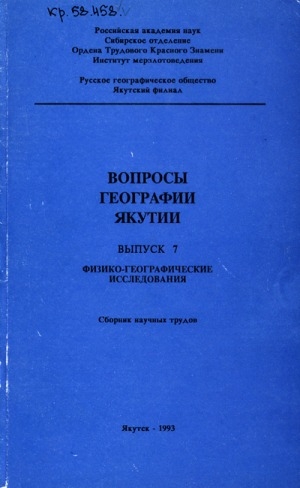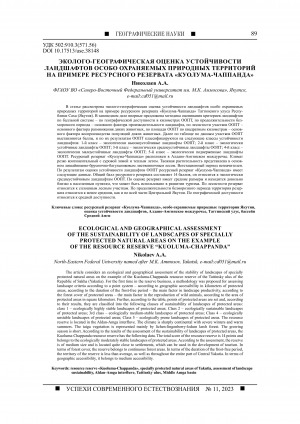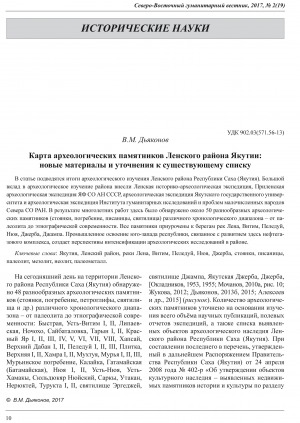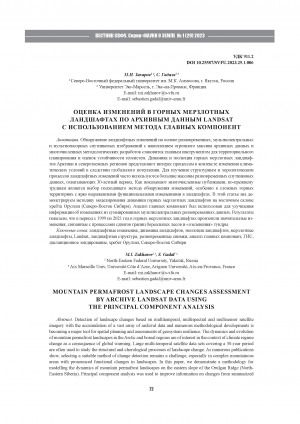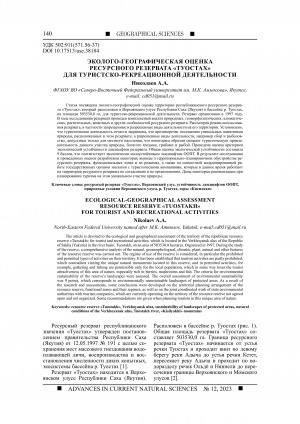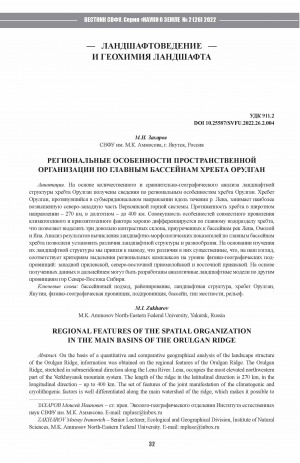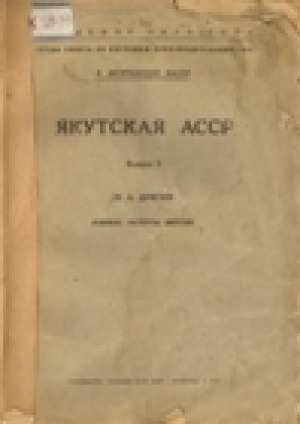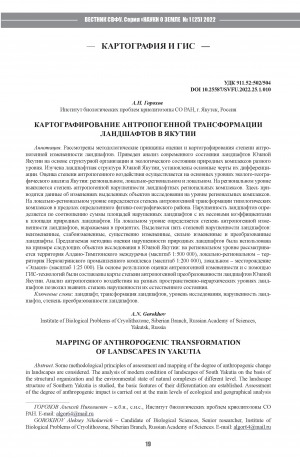Бассейн р. Вилюй расположен на территории Западной Якутии, наиболее освоенной и промышленно развитой части Якутии, имеющей важное экономическое и стратегическое значение для России. Регион является центром алмазодобывающей промышленности РФ, где разрабатываются коренные и россыпные месторождения алмазов, расположен каскад ГЭС на р. Вилюй и Вилюйское водохранилище. Это влечет экологические и социальные проблемы, негативно воздействуя на все компоненты природной среды. При исследовании различных аспектов состояния природной среды необходимо изучение устойчивости северных ландшафтов к техногенному воздействию и изучение гидробиологического состояния водных экосистем, в частности состояния альгофлоры водотоков. Проведена оценка степени устойчивости ландшафтов территории бассейна р. Вилюй к техногенному воздействию по мерзлотным и биоклиматическим показателям. Выявлено, что северотаежные редколесные и маревые ландшафты обладают преимущественно слабой степенью устойчивости, среднетаежные - средней степенью устойчивости. Наиболее неустойчивыми по всем показателям явились горно-тундровые ландшафты, характеризующиеся наиболее холодными и влажными условиями. Проведено исследование современного гидробиологического состояния рек бассейна Вилюя, в результате которых определено низкое развитие фитопланктона и фитоперифитона в р. Ирелях, М. Ботуобуйа и в верхнем течении р. Вилюй, состоящего из однообразного видового состава диатомовых и зеленых водорослей. Максимальная средняя численность водорослей варьирует от 82290 кл/л до 20700 кл/л, наибольшая биомасса отмечена на одном участке и составляет 1,58 мг/л. Индекс биоразнообразия по Шеннону - Уиверу варьирует по точкам отбора проб по течению р. Вилюй от 0,19 бит/экз. и 1,00 бит/экз. до 2,40 бит/экз. По санитарно-биологической характеристике выявлены массовые виды - индикаторы сапробности воды, что говорит о III-м классе чистоты воды, определенной как умеренно загрязненная. Таким образом, состояние альгофлоры находится под влиянием техногенной нагрузки от предприятий алмазодобычи и энергетики. Работа выполнена по госзаданию по теме "Растительный покров криолитозоны таежной Якутии: биоразнообразие, средообразующие функции, охрана и рациональное использование" (код научной темы: FWRS-2021-0023; номер госрегистрации в ЕГИСУ: АААА-А21-121012190038-0) и в рамках проекта государственного задания (ө FWRS-2021-0014) программы по приоритетному направлению ПФНИ РФ на долгосрочный период (2021-2030 гг.).
The Basin of the Vilyui river is located on the territory of Western Yakutia, one of the most developed and industrialized parts of Yakutia, which is of great economic and strategic importance for Russia. The region is the center of the diamond mining industry of the Russian Federation, where primary and alluvial diamond deposits are developed, a cascade of hydroelectric power stations is located on the river Vilyui. This causes environmental and social problems, negatively affecting all components of the natural environment. It is necessary to study the stability of northern landscapes to technogenic impact and study the hydrobiological state of aquatic ecosystems, in particular, the state of the algoflora of watercourses. As a result of studying the degree of stability of landscapes in the basin of the river Vilyui to technogenic impact on permafrost and bioclimatic indicators, the degree of their resistance is determined. It was revealed that, according to the permafrost characteristics, the northern taiga open forest and haze landscapes are defined as predominantly weakly resistant, the middle taiga as medium resistant. The most unstable in terms of bioclimatic indicators were mountain-tundra landscapes, characterized by the coldest and most humid conditions. As a result of studies of the current hydrobiological state of the rivers in the basin of the river Vilyui determined the low development of phytoplankton and phytoperiphyton in the river Irelyakh, M. Botuobuya and in the upper reaches of the river Vilyui, consisting of a monotonous species composition of diatoms and green algae. The maximum average number of algae varies from 82290 cells/l to 20700 cells/l, the highest biomass was noted in one area and is 1.58 mg/l. The Shannon-Weaver biodiversity index varies by sampling points along the river. Vilyuy from 0.19 bits / copy. and 1.00 bits/copy. up to 2.40 bits/copy. According to the sanitary-biological characteristics, mass species-indicators of water saprobicity were identified, which indicates the III class of water purity, as moderately polluted. Thus, it was determined that the state of phytoplankton and phytoperiphyton is under the influence of the technogenic load of diamond mining and hydropower enterprises.The work was carried out according to the state assignment on the topic “Vegetation cover of the permafrost zone of the taiga Yakutia: biodiversity, habitat-forming functions, protection and rational use” (scientific topic code: FWRS-2021-0023; draft state task (No. FWRS-2021-0014) of the program in the priority area of the PFNI RF for the long-term period (2021-2030).


